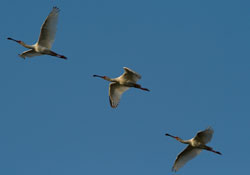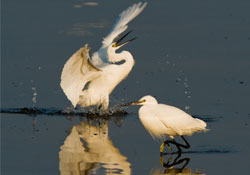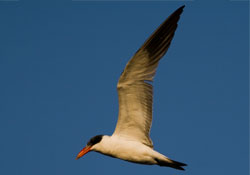|

What are migratory birds?
 Avian migration is a natural process, whereby different birds fly over distances of hundreds and thousands of kilometres in order to find the best ecological conditions and habitats for feeding, breeding and raising their young. When the conditions at breeding sites become unfavourable due to low temperatures, migratory birds fly to regions where conditions are better. Avian migration is a natural process, whereby different birds fly over distances of hundreds and thousands of kilometres in order to find the best ecological conditions and habitats for feeding, breeding and raising their young. When the conditions at breeding sites become unfavourable due to low temperatures, migratory birds fly to regions where conditions are better.
There are many different migration patterns. The majority of birds migrate from northern breeding areas in the summer, to southern wintering grounds. However, some birds breed in southern parts of Africa and migrate to northern wintering grounds, or horizontally, to enjoy the milder coastal climates in winter. Other birds migrate in terms of altitude, moving higher up a mountain in summer, and residing on lowlands during the winter months.
Migratory birds have the perfect morphology and physiology that enables them to fly fast and across long distances. However, their journey is often an exhausting one during which they go to their limits. The Red Knot for example, a 24 cm long wader weighing of around 220 g, breeds in Siberia and overwinters on the west coast of Africa, some even going down to South Africa. During its migration it loses nearly half of its body weight. Migratory birds therefore rarely fly to their destination non-stop but interrupt their journey frequently to rest and feed, or to sit out a spell of bad weather. Exactly how migrating birds find their flyways is not fully understood. Recent experiments indicate that they orientate along the Earth's magnetic field via special light receptors located in their eyes.
The symbolic meaning of birds and their journeys
 Humans have always been fascinated and inspired by the phenomenon of bird migration. In ancient Greece the bird of Athena represented the renewal of life. A dove, with an olive branch in its beak, returned to Noah's ark to announce the end of the deadly flood. The dove has remained a symbol of peace and hope. During the era of the Pharaohs in Egypt, the falcon had protective powers and was linked to royalty. For the Native Americans birds had different meanings, but always positive and linked to the concepts of unity, freedom, community, safe return, love and celebration of life. Humans have always been fascinated and inspired by the phenomenon of bird migration. In ancient Greece the bird of Athena represented the renewal of life. A dove, with an olive branch in its beak, returned to Noah's ark to announce the end of the deadly flood. The dove has remained a symbol of peace and hope. During the era of the Pharaohs in Egypt, the falcon had protective powers and was linked to royalty. For the Native Americans birds had different meanings, but always positive and linked to the concepts of unity, freedom, community, safe return, love and celebration of life.
In dreams birds embody fantasy, ideas and thoughts. The image of a flying bird is immediately connected with lightness and freedom, hence the expression “free as a bird”. Many people associate flocks of migrating birds in the typical V-like alignment with the change of season, but also with perfection, beauty and harmony. Until the 18th century people believed that swallows sank in mires at the beginning of autumn and appeared again as amphibians in the following spring. And still today some parents mark their houses with painted storks to indicate that a new baby has been born.
In almost all cultures, flocks of birds have announced the arrival of spring for centuries, and the yearly rebirth of nature associated with it. The social acceptance of birds as messengers of life was accompanied by the knowledge that migration had an important role to play in ecosystem functioning.
Why migratory birds need to be protected
 Many bird species migrate in order to survive. However, migration is a perilous journey and involves a wide range of threats. Only a small number of birds are actually threatened by natural events. Sad but true, human activities are the source for most dangers migrating birds are exposed to. And as diverse as people and their habits in different countries are, so are threats the birds face. Many bird species migrate in order to survive. However, migration is a perilous journey and involves a wide range of threats. Only a small number of birds are actually threatened by natural events. Sad but true, human activities are the source for most dangers migrating birds are exposed to. And as diverse as people and their habits in different countries are, so are threats the birds face.
The loss of habitats due to pollution or exploitation caused by encroachment for settlement, agriculture, grazing etc. is the main threat migrating birds face, as they are dependent on finding suitable breeding and wintering grounds as well as stopover sites along their flyways where they can rest and feed. The loss of any of these sites used by the birds during their annual cycle could have a dramatic impact on the birds’ chances of survival. Also, high-voltage power lines and wind turbines have a dramatic impact on birds, which are in danger of being killed by electrocution or collision. Poaching remains widely practised in countries where people are highly dependent on biodiversity for their livelihoods.
These are only a few examples and often a substantial decrease in population numbers within a species is the result of a combination of such factors. It is therefore hard to identify which individual factor poses the greatest threat.
Flying over long distances involves the crossing many international borders and entering different political areas with their own environmental politics, legislation and conservation measures. It is evident that international cooperation between governments, NGOs and other stakeholders is required along the entire flyway of a species in order to share knowledge and to coordinate conservation efforts.
Without national and international cooperation all measures taken to tackle the threats to migratory birds in one country could be in vain if for example unsustainable taking is accepted in another country. The necessary legal framework and coordinating instruments for such international cooperation is provided by international agreements such as CMS and AEWA.
World Migratory Bird Day has a global outreach and is an effective tool for the international community to help raise awareness on the threats faced by migratory birds, their ecological importance, and the need for international cooperation to conservation them. | 

